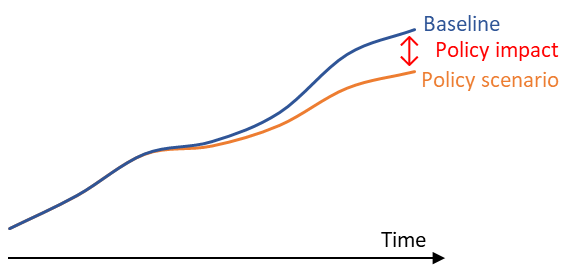Quantitative assessments of proposed policies often require a baseline for comparison. The Joint Research Centre builds such baselines by integrating macroeconomic projections and sectoral information in a consistent framework.
The resulting baseline is made available for download to increase transparency and to allow other researchers to use it in their own modelling.
Baselines as starting point for policy assessments
Quantitative policy analysis typically presents differences between a scenario with a new policy and a scenario without this new policy. This isolates the effects of the new policy from other developments, such as economic growth, changes in demographic structure, technological progress over time, or other policies already in place.
However, these elements can influence the impact of the policy. For example, the employment impacts of a more stringent climate policy on sector like coal depend not only on the new policy, but also on the development of the sector in the absence of the new policy. If the coal sector of the example is projected to continuing its declining trend already under the current circumstances, the employment impacts that can be attributed to more stringent climate policy should take this trend into account and only calculate the additional policy impact.
A baseline that is the starting point for medium to long-term policy analyses thus needs to carefully integrate key macroeconomic and sectoral trends.

Baselines are essential for any meaningful assessment of counterfactual policy scenarios as they provide a reference point for evaluating the impact of policy changes.
Building quantitative baselines
Ongoing megatrends that will shape our world and economy in the years and decades ahead should thus be integrated in a baseline – but it is often not easy to translate this into quantitative pathway into the future.
Despite modellers often spending as much time on designing the baselines as on the scenarios with a policy change, baselines typically receive much less attention and are often not very transparent.
The Joint Research Centre (JRC) work on baselines therefore aims to
- improve existing approaches to build baselines that are internally consistent by pulling together data from multiple data sources in a consistent way,
- increase transparency by publishing the global macroeconomic baselines in the JRC data catalogue and providing documentation on the applied method
- increase the usability for other researchers who can make use of the JRC baseline rather than spending much time to develop a similar baseline.
The JRC baselines featuring rich sectoral detail were used e.g. by
- the JRC-GEM-E3 model to support the in-depth assessment for the European Commission's long-term strategic vision on greenhouse gas reduction,
- the impact assessment of the 2030 climate target plan, and
- several GECO reports.
